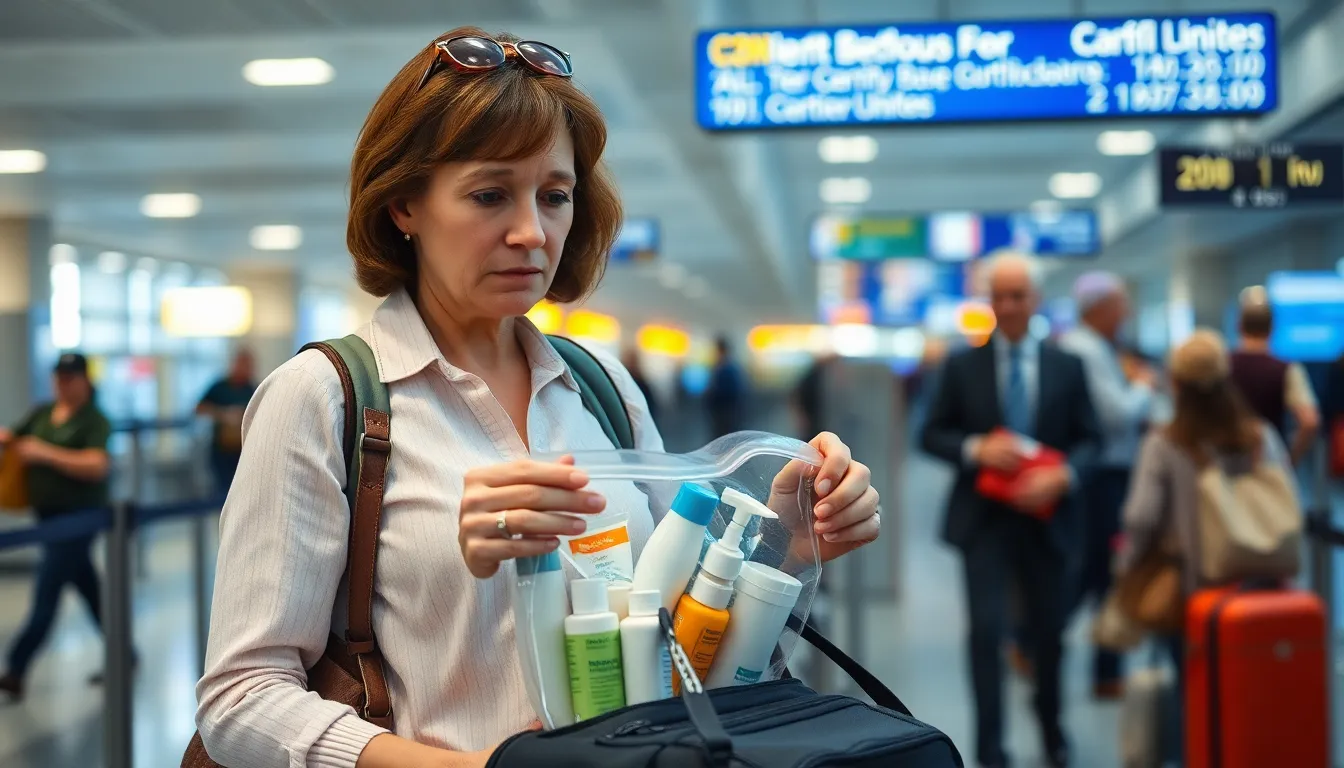Table of Contents
ToggleTraveling can feel like a game of Tetris, especially when it comes to packing that carry-on bag. Just when you think you’ve mastered the art of fitting in your favorite shampoo and that luxurious face cream, reality hits: liquid limits. It’s like a cruel joke from airport security designed to test your creativity and patience.
Understanding Carry On Bag Liquid Limit
The liquid limit for carry-on bags is crucial for travelers to grasp. Regulations from the Transportation Security Administration (TSA) dictate that each passenger can carry liquids in containers of no more than 3.4 ounces (100 milliliters). Travelers must place these containers in a quart-sized, clear, resealable plastic bag.
Many passengers overlook the total volume allowed. Each person can have only one of these bags, which means maximizing space is essential. Organizing items efficiently leads to less hassle during security checks.
Liquids include a variety of products. These include beverages, gels, creams, lotions, and even aerosols. Notably, exceptions apply for medications and baby food, which may exceed the standard limits if declared at security.
It’s important to understand how security screening works. Airport personnel will inspect the bag, ensuring compliance with regulations. Those who pack non-compliant items may face delays or have their items discarded.
Smart packing strategies yield better outcomes. Consider solid alternatives to liquids when possible. For instance, solid shampoo bars and facial cleansing wipes help to reduce the amount of liquid carried.
Travelers should also check airline policies. Different airlines might have specific restrictions in addition to TSA regulations. Staying informed will streamline the boarding process and enhance the travel experience.
Regulations for Carry On Bag Liquids

Travelers must adhere to strict regulations regarding liquids in carry-on bags. Understanding the specific guidelines ensures a smoother security experience.
TSA Guidelines
TSA regulations state that liquids must be in containers of 3.4 ounces (100 milliliters) or less. Each passenger can bring a quart-sized, clear, resealable plastic bag filled with these containers. Passengers should always remember that all liquids must fit inside this bag. Gels, creams, and aerosols fall under these restrictions, along with beverages. Medications and baby food offer some flexibility, provided travelers declare them at security.
International Regulations
International flights may impose varying liquid regulations outside TSA rules. Many countries follow similar liquid limits but may have different allowances. For instance, the European Union allows 100 milliliters per container, similar to TSA guidelines. Some regions may also permit exceptions for duty-free liquids purchased after security. Understanding these distinctions helps travelers pack appropriately and comply with varying requirements efficiently.
Types of Liquids Subject to Limits
Understanding the types of liquids subject to TSA limits ensures smoother travel experiences. Passengers encounter various items that fall under these regulations.
Common Items in Carry On Bags
Beverages such as water, juice, and soda rank among the most common liquids travelers pack. Gels, creams, and lotions for personal care, like moisturizer and sunscreen, also require scrutiny. Shaving foam and hair gel often find their way into bags too. Many forget about essential items, including mouthwash and perfume, which contribute to the overall liquid volume. Aerosols, like deodorant and household sprays, also belong to this category. Each container must not exceed 3.4 ounces and fit within the quart-sized bag requirement.
Exceptions to the Rules
Certain items enjoy exemptions from the strict liquid limits. Medications, both prescription and over-the-counter, can surpass the usual constraints once declared at the security checkpoint. Baby food and formula are also exceptions, allowing parents to carry what’s necessary. These must be presented separately for inspection. Additionally, duty-free liquids purchased in shops after security checks may not adhere to standard limits. Travelers should store these items in compliant packaging to avoid complications. Knowing these exceptions can significantly ease the burden of packing for travel.
Tips for Packing Liquids
Packing liquids efficiently makes a significant difference for travelers. Following a few best practices promotes an organized carry-on experience.
Best Practices for Travelers
Use a checklist to ensure essential liquids are not forgotten. Organize items by frequency of use; keep essential ones accessible. Consolidating items into multi-use products reduces overall volume. Travel-size container options for shampoos and conditioners are widely available and practical. Familiarize with TSA guidelines to prevent surprises during security checks. Arrive early to allow ample time for packing and screening processes. Connecting through multiple airports may require revisiting regulations, so staying informed can help travelers adapt.
Recommended Containers and Sizes
Select quart-sized, resealable plastic bags that conform to TSA standards. Individual containers must not exceed 3.4 ounces (100 milliliters) each. Utilize label containers to identify contents easily. Consider using compression bottles to maximize space while adhering to size limits. Opt for containers made of flexible material, as they can often fit better in packed areas. Store liquids strategically at the top of the bag for quick access at security checkpoints. Employ travel-sized refillable containers to minimize waste and save money on expensive airport products.
Navigating liquid limits for carry-on bags doesn’t have to be a daunting task. By understanding TSA regulations and international guidelines travelers can pack smarter and avoid unnecessary stress at security checkpoints. Utilizing solid alternatives and multi-use products can not only save space but also enhance convenience.
Adopting efficient packing strategies like using a checklist and organizing items by frequency of use can streamline the travel experience. With a little preparation and awareness of the rules travelers can enjoy a smoother journey, ensuring that essential liquids are easily accessible while staying within the required limits. Embracing these practices will lead to a more enjoyable and hassle-free travel adventure.




